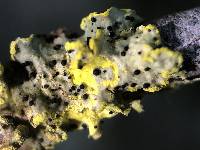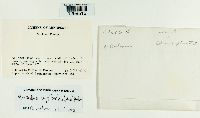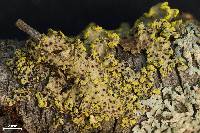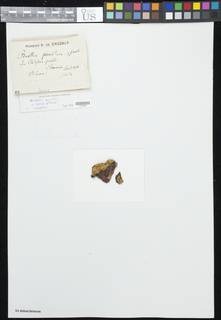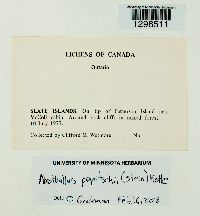
Consortium of Lichen Herbaria
- building a Global Consortium of Bryophytes and Lichens as keystones of cryptobiotic communities -
- Home
- Search
- Images
- Species Checklists
- US States: O-Z >
- US National Parks
- Central America
- South America
- US National Parks
- Southern Subpolar Region
|
|
|
|
Family: Lichenoconiaceae
[Abrothallus parmeliarum var. peyritschii Stein] |
Nash, T.H., Ryan, B.D., Gries, C., Bungartz, F., (eds.) 2004. Lichen Flora of the Greater Sonoran Desert Region. Vol 2. Mycelium: I+ blue Apothecia: initially immersed, becoming superficial, 130-250(-350) µm in diam. disc: black, not or slightly pruinose, applanate to ±convex epihymenium: aeruginose green, later brownish green, K+ intensively green, N+ brown violet, K/HCl+ violet, with a dark olivaceous crystal layer, crystals K+ yellow, dissolving in K hymenium: hyaline to pale brownish, in upper part pale green, K+ green hypothecium: reddish brown, K-, outer part I+ blue, centrally c. 150 µm tall asci: elongate ellipsoid to clavate, 8-spored, I-, 55-60 x 12-16 µm ascospores: pale green, then brown, K+ blue-green, verrucose, 1-septate, upper cell slightly broader, 10.5-13 x 4.5-6 µm Pycnidia: black, ±immersed; outer wall: in lower part hyaline, I+ blue, in upper part brown to aeruginose, K+ green; inner wall: entirely I- conidia: hyaline, ellipsoid, obpyriform to almost triangular, (5-)5.5-6.5(-7.5) x (3.5)4-5(-6) µm. Host: thallus of Vulpicida pinastri, not obviously damaged by the fungus; the parasitic mycelium is abundant in the host thallus, including in the soredia; young developing thalli of Vulpicida may thus be infected since the beginning World distribution: Europe, North America, Asia and New Zealand Sonoran distribution: once collected in Arizona. Notes: Abrothallus peyritschii is easily recognized by the host selection (Vulpicida pinastri), by the mycelium becoming blue in I, the relatively small apothecia and the small ascospores and conidia. |
Powered by Symbiota




